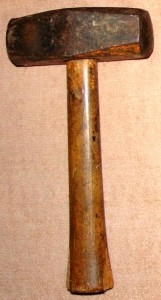In June 1936, Max Edmond Hahn (1897-1989) and his wife Emma Zadie Hahn (née Pearl) (1899-1995) were walking along Red Creek, near their home in London (Texas, USA), when they spotted a rock nodule with a piece of wood sticking out from it. It was sitting on a ledge by a waterfall on the river, not attached to any of the solid rocks around it. There are several areas where small waterfalls exist on Red Creek, the closest being about 10 km south-west of London. According to some versions of the story, the discovery took place in 1934; sometimes, Max is called Frank, for reasons unknown. Some time later (perhaps in 1946 or 1947), their son George (1921-2011) broke it open, to reveal a metallic hammerhead in the centre of the nodule, to which the wooden handle was attached. Part of the broken nodule has survived and has an unfossilised mollusc shell partly embedded in it (photograph here). Inside the nodule was a metallic hammerhead, to which the wooden handle was attached. The hammer was clearly of recent manufacture.
The London Artifact as museum display
That ought to have been the end of the story. A nineteenth-century quarryman or rockhound dropped a hammer near a waterfall on Red Creek. However, it came to the attention of the Young Earth creationist Carl Baugh (born 1936). It is unclear if Baugh was alerted to the hammer by an article by Walter Lang (1913-2004) in the Bible-Science Newsletter 21 (6), 14, ‘Modern hammer in Silurian rocks’, or vice versa. Baugh purchased the object around 1983 and began to promote it as ‘the London Artifact’ at his Creation Evidence Museum, which opened in 1984.
On the Museum’s website, Baugh asks:
“If the artifact is truly from the Cretaceous time frame, where does this leave evolutionary theory, since man was not supposed to have evolved for another 100-million years or so? If the artifact is relatively recent, that means that the Cretaceous Hensell Sand formation from which it came is relatively young… Again, where does that leave evolutionary theory with its traditional dates for the Cretaceous formations?”
The Museum sells replicas of the hammer, one of its star exhibits.

A nineteenth-century mason’s hammer. The resemblance to the “London Artifact” is unmistakable. [Source]
Walter Lang appears to be the first to claim that the hammer had been studied by metallurgists at a laboratory in Columbus, which has widely been taken to mean Battelle Memorial Institute. Creationists still like to repeat this. However, the claim was directly rebutted in the February 1985 issue of Creation Ex Nihilo. According to Lang, the scientists “were convinced that the rock itself could not have been formed except where there was a great deal of water and pressure” and that the handle had been “partly coalified… under pressure with water and volcanic action”. If The Battelle Institute did not supply the data, where did Lang get the opinions? Might they have come from Baugh?
The nodule
The nodule in which the hammer is embedded is the real source of the claims of antiquity. If it is genuinely part of the local geology, then it potentially provides evidence either for the recent formation of the rocks – as Baugh would like – or it provides evidence for human (or human-like) technology in the very remote past indeed. However, there is no evidence whatsoever that the nodule was ever part of the bedrock (which, incidentally, is Cretaceous, not Ordovician in date). Remember, it was found on a ledge near a waterfall. This is the key to understanding the object.
The nodule is not a detached part of the bedrock, but a concretion made from once dissolved carbonate minerals that precipitated out as the water evaporated. In other words, the nodule could easily be of nineteenth-century date. Instead, we see the claim for (relative) antiquity parroted on websites, sometimes with reference to a book by Hans-Joachim Zillmer, Darwin’s Mistake: Antediluvian Discoveries Prove Dinosaurs and Humans Co-existed (Frontier Publishing, 1998). Zillmer makes a great play of the chemical composition of the hammerhead, reporting that it consists of “96.6% iron, 2.6% chlorine and 0.74% sulphur”; this is the analysis that is often wrongly attributed to the Battelle Memorial Institute. Those dependent on this unsourced analysis have tried to claim that this is an impossibly pure form of iron and that iron cannot be combined with chlorine. These claims are nonsense. For one thing, steel contains 98-99.8% iron, while many iron ores (such as biotite) or meteoritic iron naturally contain chlorine, so it’s not a question of adding it. Finally, the idea that the handle has turned to coal is just plan silly. It is quite visibly wood, although the ends apparently show a little carbonisation. Carbonisation is a process that can happen to vegetable matter, especially wood, on heating. It is not “partly coalified”. If anything, it’s on the way to becoming charcoal.
Conclusion: the London Artifact is a hammer partly embedded in a concretion
There is no evidence whatsoever that the nodule was ever part of the Red Creek’s geology, which is the Lower Cretaceous Hensel Sand Formation. These deposits are thought to be roughly 110-115 million years old. Having acquired the object in the early 1980s, Baugh promoted it as a ‘pre-Noachian’ artefact (in other words, dating from a time before the mythical Flood of Noah). However, it was soon pointed out by a geologist that minerals dissolved from ancient strata can harden around a recent object, making it look impressive to someone unfamiliar with geological processes. In fact, the style of the hammer would lead us to recognise it as nineteenth-century in date and of definitely American provenance.


145 Responses to The London Artifact (Texas)